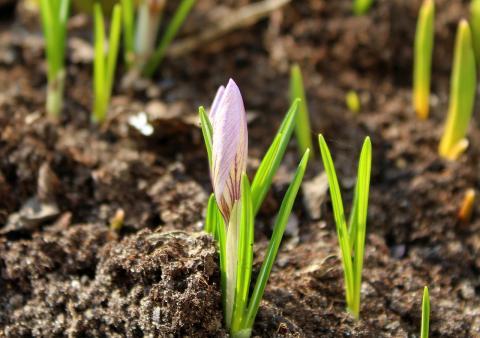
With the turn of spring, the desire to garden increases—at least for me. For those living in cooler areas of the country, rainy days and fall’s leftover leaves might be reason enough to ditch the garden and stay indoors, but taking care of your garden now means bright, vibrant blooms all summer long. Fertilizing your plants is necessary to boost growth or blooms, specifically because most soil is severely depleted of nutrients following years of pesticides, toxins, and overuse. While many fertilizers are comprised of harsh chemicals that are carcinogenic and dangerous to kids and pets alike, organic fertilizers are a safe alternative. Here are five ways to fertilize your plants this spring—the healthier way.
1. Compost or Organic Fertilizers
Grass isn’t the best choice for a yard (think veggie boxes or native plants), but if your front lawn is looking yellow or you’re simply hoping to ditch the chemical cocktails that your grass drinks up, try this instead. Spread a thin layer of homemade or organic compost over your lawn. Decomposed fruits, veggies, and other plant matter create a healthy environment full of beneficial bacteria for your grass. Adding this can help to boost the health of your soil. If fertilizer is still a consideration, consider picking up an organic fertilizer at your local nursery. Look for ingredients like bone meal (for phosphorous), seaweed (for potassium), or earthworm castings.
Organic fertilizers are often just as readily available as conventional ones at most nurseries, and can be used for everything from tropical plants to cactuses, as labeled.
2. Eggshells
Eggs are nature’s perfect food for many reasons, and here’s yet one more: eggshells! Eggshells naturally contain calcium and when crushed are easily absorbed into soil. Save eggshells in a large container, then dry. Once completely dry, crush by hand or add them to a food processor to grind into very small particles (be careful not to inhale the dust!). Add to soil, and gently mix.
3. Coffee Grounds
Make your own coffee? Don’t toss your coffee grinds (or at least save some after making your own homemade body scrub or facial.) Rinse used coffee grounds, then scatter around plants and into the soil. While it may take awhile for the coffee to break down, once decomposed it will add a boost of nitrogen. Be careful not to add too much directly to the soil; instead, scatter a thin layer on the soil and gently rake it in, ensuring that there are no remaining clumps. While coffee is acidic, used coffee beans are closer to neutral.
4. Tea Leaves
As a tea drinker, I’m often left with heaps of used tea leaves. Used leaves boost nitrogen-content, but be careful not to use tea bags: These take much longer to disintegrate and are better placed in the compost. Like with coffee, spread a thin layer around your plants and then rake it into the soil. Be careful when using tea leaves indoors. Overly wet tea, especially if it contains fruit or tisanes, can encourage fruit flies and other insects to gather.
5. Epsom Salt
Epsom salt is rich in magnesium (hence my love of a hot Epsom salt bath to relax post-workout), and is equally as beneficial to plants as it is to humans. Magnesium can boost the taste of your vegetables and the blooms of your flowering plants, but it’s important to dilute the solution. Most recipes, like this one, advise using 1-2 tablespoons of Epsom salt per gallon of water. Simply mix the Epsom salts until dissolved, then water regularly.
What is the best time to apply fertilizer in the spring?
It’s generally advised to fertilize following the appearance of the first leaves. However, if you live in a region where the last frost date is late, wait until it has passed before applying fertilizer. Once the first flowers have appeared, it may be useful to apply a second application of fertilizer to boost growth.
Indoor plants, on the other hand, can be fertilized monthly (except in winter months).
How do I apply fertilizer?
Always apply fertilizer in the morning (just like when you’d water your plants). Also, it can be helpful to fertilize, then water, in order to prevent clumping or burns on your plant from the fertilizer itself.








